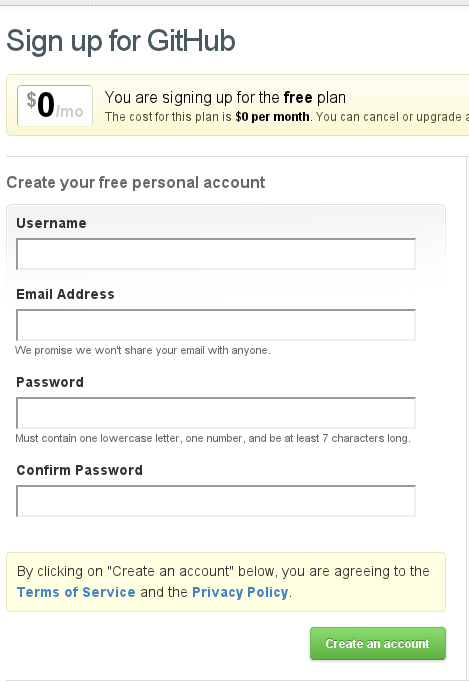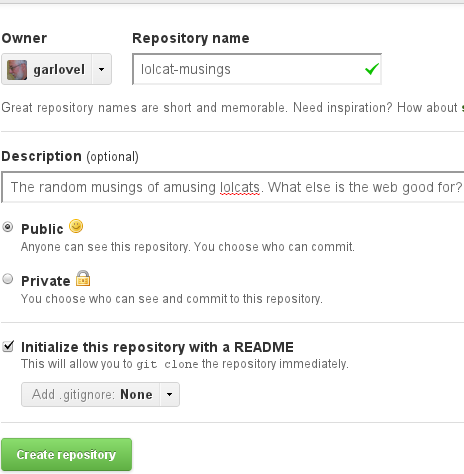Right Hosting¶
From the many options for free repository storage and hosting, one is enough. This guide recommends GitHub for its excellent documentation and good feature set. [1]
Register a GitHub Account¶
If you lack a GitHub account, here are instructions.
Register for free:¶
- Click this link to the GitHub signup page.
- Enter your information (four fields).
- Click on Create an account.

Copy SSH Key to Clipboard¶
At your system console, copy your SSH key to the clipboard with the command:
cat ~/.ssh/id_rsa.pub | xclip
Add the SSH Key to Github:¶
- Click the wrench to the right of your name, Account Settings,
- Then select SSH Keys from the settings menu on the left.
- On the “SSH Keys” bar, click the Add SSH key button.

- Click in Key, and press <Ctrl-V>.
- Click in Title, and enter the workstation@username and date.
- Click the button Add key to finish.

Verify ssh with login¶
- Back to the console, enter ssh -T git@github.com.
- At the “Are you sure ... (yes/no)?” question, type yes, press <Enter>.
- You should get a response that you have successfully authenticated:

Note
Each workstation you use will require a different ssh key.
Fork a Remote Project¶
There is no need to start from scratch when creating a documentation project. Instead, clone or fork someone else’s open source work. With your GitHub account,
- visit my GitHub page
- find the self-publish repository and click the name,
- then click the fork button at the top right of the page.

GitHub will make a copy of the self-publish repository for you, and then switch to view your copy.
Clone a Remote Project¶
Once you own a repository on GitHub, you will want to clone it. The GitHub repository is remote, and cloning makes a local copy which you can edit. Here is the console command:
git clone (link_to_your_project) ~/Projects/doc-publishself
There are two parameters to the git clone command. First is your project name, which is the text following “Git Read-Only” in the image below. (But copy the text from your fork of the repository please, so it will have your name instead of mine.) The second parameter is the folder name to create for the project.

Ask Git a Question¶
Type the following commands to query git in the doc-publishself project:
cd ~/Projects/doc-publishself
git branch -a
Git shows two branches in this project, gh-pages and master, and master is active. If the source is in branch master, then what is in the gh-pages branch?
Git an Answer¶
The answer is, gh-pages contains HTML pages and other content for the website you are viewing.
Now let’s create a gh-pages branch for your doc-firsttask repository. Here are the commands:
cd ~/Projects/doc-firsttask
git add .
git commit -m "Commit all current changes before branching"
git symbolic-ref HEAD refs/heads/gh-pages
rm .git/index
git clean -fdx
git branch master
Refer to the Project Pages Manually section of GitHub help for more information.
Pushing to GitHub¶
You may have noticed: doc-publishself contains a repository from GitHub. Committed changes in the doc-publishself folder are updated to GitHub with the command git push.
Moving Projects to GitHub¶
On the other hand, the doc-firsttask repository is local to your workstation. To archive and share and existing project, you need to create a repository on GitHub. On your GitHub home page, click the New repository button, describe the repository, and then create it.


Your new GitHub repository will display a remote link address, somewhat like git@github.com:__username__/__repositoryname__.git. Using the following commands as a template, you can update your local repository to point to the new GitHub repository as a remote master:
cd ~/Projects/doc-firsttask
git remote add origin git@github.com:_username_/_repository_.git
git merge origin
Warning
Use the remote URL for your repository in the preceding commands, instead of pasting in git@github.com:_username_/_repository_.git.
Footnotes
| [1] | Wikipedia shows a comparison of options for free repository hosting at http://en.wikipedia.org/wiki/Comparison_of_open_source_software_hosting_facilities. |